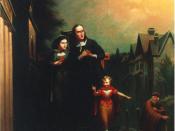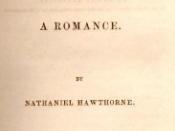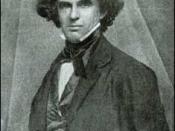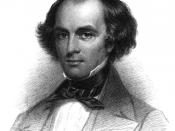The Quartet Behind The Scarlet Letter Nathaniel Hawthorne had many different characters in his novel The Scarlet Letter, but very few of them are actually put to use. In fact, only four of them really count. They are Hester Prynne, Pearl, Arthur Dimmesdale, and Roger Chillingworth. They all have their own meanings. For example, Hester is for love, Dimmesdale is the spirit, and Chillingworth is the mind (Roper 112). Each member of the four has a unique struggle and makes their own input on the outcome of The Scarlet Letter.
Hester Prynne was a very important character in the novel. At the opening she is being brought out of Salem's by the town beatle for punishment upon the scaffold. She resents this treatment, and this sets up the conflict between her and the Puritan society (Brodhead 45). She was spared the gripe about the head and neck, yet she and her daughter, Pearl, must endure public humility for the next three hours in the burning June sun (Gordon 26).
Her crime was adultery against her husband, known as Roger Chillingworth, who had went out into the world to seek his fortune in medicine. It is really shocking that she could do this, seeing that she lived in the Puritanical village of Salem. In fact, she seems to be a feminist in this aspect, daring to rise up and challenge the laws about women (Crowley 63). After this incident, she was taken back to her prison cell and there she waited until the magistrates decided to release her. At first, she was definitely isolated from society, but there are still traces of intercourse with society (Axelson 77). However, her needlework fascinated many people and was fashionable among the upper ranks of the Puritans (Newberry 5). Yet she feels that she has been taken advantage of by Chillingworth, who makes her keep his identity secret while he searches for the one who sinned with Hester (Axelson 80). Her response to this is one of the determining factors of the end of the story.
Pearl, born in the Salem jail, was the daughter of Hester Prynne and Arthur Dimmesdale, a well respected Puritan priest.
She is not that important to the outcome of the story, but still, she has many qualities and seems to be the most complex figure in this novel(Abel 204). When she was born, she had no defects, in fact, she was worthy to have been born in Eden (Hawthorne 92). Her name came about not from her aspect, which had nothing of the calm, white, unimpassioned luster of pearl, but it was because she was her mother's greatest treasure, the one she paid a great price for (Hawthorne 91). In Pearl's early years, she symbolized childhood with its undeveloped human and moral responsibility (Abel 170).
Pearl differed from the other children that lived in the Puritan neighborhood. The village children lacked the childlike energy and freedom when they were compared to Pearl (Johnson 62). She was really more in tune with nature than she was with the human community (Abel 195). Her traits included her violent displays of temper, lively imagination, and curiosity (Abel 199). Yet the absence of a father in her life is a serious void in her life (Miller 279). It is certain that she felt this and that it helped create some of her feelings. When the Reverend finally confessed himself to her, she seemed to understand why the void was there. Her father never gave her anything however. It is ironic that the one who tortured her father's soul, Chillingworth, gave her a large inheritance when he died. But what happened to her after this? A question remains as to what really happens to Pearl (Hutner 29).
Arthur Dimmesdale was a priest in the town of Salem. He became the lover of Hester Prynne in the Massachusetts woods. His tremulously sweet, rich, deep, and broken voice was his gift to the ministry (Hawthorne 73). He is considered by many to be saintly, but that is far from true. No, he had many faults, yet he kept them locked up inside the dungeon of his heart (Brodhead 32). His fault was not his affair, but it was his unwillingness to confess, his hypocrisy (Abel 183). He was neither saintly nor villainous. He was egotistical, self-deluded, and entirely passive. He is a pathetic, failed human, that shows the potential disaster to which a conflict between creativity and morality may lead the narrator (Johnson 55-56, 65). His sin brought him an even deadlier friend: heart disease. He was seen on any slight alarm or other sudden accident to put his hand over his heart (Hawthorne 119). But he was egotistical, and he made his last stand on the Election Day, preaching the best sermon he had ever preached before (Newberry 186).
Roger Chillingworth was Hester's husband. He was the main offender against Hester, marrying her before she was mature enough to know the needs of her nature. He was capable of love, and should be sympathized with for his desire of a life cheered by domestic affections But he was disappointed in his hope of gaining his wife's affection, and hated the man who had gained it unsought and eventually unwished. At first his anger was natural and forgivable, but it became fatal when he nourished it (Abel 182, 208-209). Although he thinks it is Hester's betrayal that has changed him from a kind, loving, gentleman, to a vengeful devil, it may really be that he is really physically and sexually inferior to Dimmesdale. He transformed his healing sympathy into destructive and slef-distorting faculty (Hutner 31, 42). The real irony is that in trying to damn Dimmesdale he damns himself (Crowley 68).
The Scarlet Letter is about all of these charcters who tried to find the true meanings behind their feelings. Some of them succeeded. Hester, Pearl, and Arthur did. There is a trace of evidence that Roger Chillingworth changed his ways after Dimmesdale died, but we don't know that for sure. What we do know for sure is that each of the characters had a struggle and made their own imprint on The Scarlet Letter.
Works Citied Abel, Darrel. The Moral Picturesque: Studies in Hawthorne's Fiction. West Lafayette: Purdue University Press, 1988.
Axelson, Arne. "The Links in the Chain: Isolation and Interdependence in Nathaniel Hawthorne's Fictional Characters." Diss. Uppsala University, Uppsala, 1974.
Brodhead, Richard H. Hawthorne, Melville, and the Novel. Chicago: University of Chicago Press, 1976.
Crowley, J. Donald, ed. Nathaniel Hawthorne: a collection of criticism. New York: McGraw-Hill Book Company, 1975.
Hawthorne, Nathaniel. The Scarlet Letter. New York: Penguin Books, 1850.
Hutner. Gordon. Secrets and Sympathy: Forms of Disclosure in Hawthorne's Novels. Athens: University of Georgia Press, 1988.
Johnson, Claudia D. The Productive Tension of Hawthorne's Art. University: The University of Alabama Press, 1981.
Miller, Edwin Haviland. Salem is My Dwelling Place: A Life of Nathaniel Hawthorne. Iowa City: University of Iowa Press, 1991.
Newberry, Frederick. Hawthorne's Divided Loyalties: New England and America in his works. Cranbury: Associated University Press, 1987.
Roper, Gordon. "Hawthorne, Nathaniel." World Book. 1983 ed.





